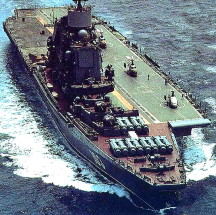INDIA DEFENCE CONSULTANTS
|
WHAT'S HOT? –– ANALYSIS OF RECENT
HAPPENINGS |
|
GORSHKOV, NAVAL LCA AND MiG-29K An IDC Analysis
|
|
New Delhi, 21
April 2003
The
$13.8bn Defence Budget for India stands passed. Hence it is
decision time and the Government paid out the first installment of
crores for the Air Defence Ship to Cochin Shipyard. The money
for the advance for Gorshkov and MiG-29Ks has been ‘set aside’
again in the 2003 Budget but the Indian decision making is taking
time. Financial
Express stated that the decision for the MiG-29Ks is now almost sure
when the Gorshkov is signed for, but hinted that the decision for
Gorshkov itself may take time. We ask why is it so? Media reports it
is because of the price difference and it’s linked with the 4
TU-22M and lease of two Akula nuclear submarines. If that be so, why
can’t the powers that be, sit down and sort it out or will $1.7bn
be returned again next year, just to see that the fiscal deficit is
contained? We
offer the merits of MiG-29K to doubting Thomases and some insights.
The naval version of LCA can be ruled out as it is totally uncertain
to be available when the ADS is launched and sets off for trials. If
the Naval LCA comes about it can be accommodated but it should not
form the basis of the ADS design. If
the decision is taken the IAF may also gain as the older MiG-21s
need urgent replacement. The scaled down SU-30s, which have been
appreciated by the IAF Chief and the pilots publicly, could also be
thought of. George Fernandes just stated that the IAF request for
the 130 fighters is still being considered. With
the announced selection by the media of the Russian MiG-29K and
confirmed by Indian naval officials for operation from the
aircraft-carrier 'Admiral Gorshkov', the Russian aviation industry
is all set to put its best foot forward to impress the officials of
both Indian Navy and IAF to secure more export orders. More
importantly, the Russians are targeting the possible short to medium
term replacement of the accident-prone MiG-21 fleet of the IAF with
a "scaled down Sukhoi-30", retaining a good percentage of
the avionics component of Sukhoi-30MKI. Their only rival in the
endeavour appears to be the French Mirage 2000-5Mk2 while the
inconsistent attitude of United States administration in relation to
the Phalcon AWACS (Airborne Warning And Control System) deal has
perhaps jeopardised the projected Lockheed Martin F-16 sale to IAF. MiG-29K
(Korablny, meaning ship based) holds the distinction of being the
second fighter type to land on the Russian aircraft-carrier 'Admiral
Kuznetsov' after Pugachev's Sukhoi-27 and the first type to take-off
from that ship. Pilot was Takhter Aubakirov. MiG-29K is based on the
fly-by-wire Attention
should now firmly focus on the Naval LCA project. LCA is somewhat
similar in size and configuration to the Swedish Gripen (Griffin)
that attained IOC (Initial Operational Capability) in 1997 and is
all set to receive a major upgradation before 2010. Ericsson the
same radar agency Also
required is a formidable defensive avionics suite, which detects the
threats of not only incoming radar guided missiles, but also of
missiles that use the infra-red and ultra-violet spectrum. Add to
all these a laser "device" capable of generating directed
energy to snap the guidance of incoming radar and infrared guided
AAMs seems to be obligatory on all fighters by the middle of the
next decade. India's own laser technology status is decades old and
at least one less reliable media source has predicted integration of
'Kali' the particle beam weapon, with LCA. Finally,
thrust-vectoring engines may prove to be invaluable in both MiG-29K
and Naval LCA. Generally thrust vectoring is associated with WVR
(Within Visual Range) combat but may prove to be of immense value in
dodging incoming BVR missiles at extreme ranges. Moreover certain
manoeuvres like 'cobra' can be very effectively conducted with
thrust vectoring engines. Below the "clutter notch" of
enemy aircraft are bound to make them invisible to enemy radar at
critical moments. Modern pulse-Doppler radar after all, filters out
static and semi-static objects at lower level to "gather"
moving targets. Every
effort should be made to provide an excellent naval fighter for
protection of high-value naval task groups. Modern navies have
traditionally assigned their best fighter design to their
aircraft-carriers from time to time, exemplified by United Stated
F-14 and F-18, Russian Sukhoi-33 and French Rafale. Space and
technological restrictions prevented both the Russian Sukhoi-33 and
French Rafale to be accommodated on 'Admiral Gorshkov', therefore
maximum punch needs to be packed within the MiG-29K and Naval LCA
design. (With Inputs from Sayan Mazumdar)
|
